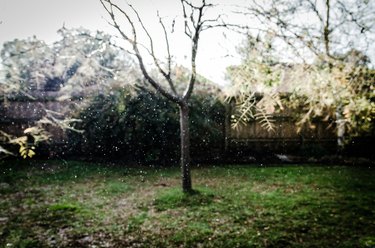Winter isn't everybody's favorite time of the year, though it certainly has its own charms. It's the time of the year when nature presses "reset" and sets the table for spring, and it's smart for humans to do the same. You'll enjoy the winter more, and make less work for yourself in spring, if you take the time in autumn to do some basic prep work and put your yard and garden to bed for the winter.
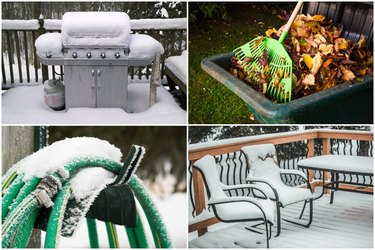
Video of the Day
1. Winterize Your Grill
If you don't plan to use your grill until spring, this one's easy: Clean it, roll it into your garage or basement, and forget about it. If you'd like the option of using your grill through the winter as weather permits, there are a few more steps. You should still give it a good end-of-season cleaning, but then invest in a good-quality, weatherproof cover to protect it from the elements. Consider moving it to a sheltered spot closer to the house, as well, but not so close that you risk melting your siding, starting a house fire or having smoky, greasy air near the furnace's intake.
Video of the Day
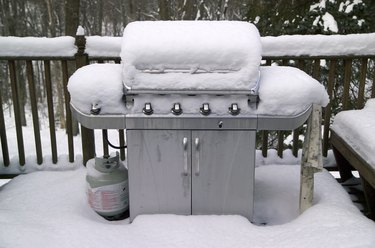
2. Drain Your Hose and Spigots
One of the more urgent, late-autumn tasks is dealing with your outdoor water system. Start by turning off the water supply to your outdoor spigot, then turning it on to drain as much water as possible. If you don't do that, an extra-harsh winter might conceivably freeze and burst your pipes, which would make for a nasty surprise when springtime rolls around. While you're at it, drain your hoses, roll them up and put them away for the winter. Wintertime freezing can cause them to split and leak as well, a cost (and annoyance) that's easily prevented.
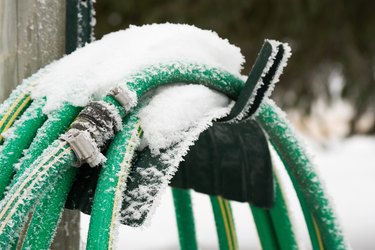
3. Take Care of Outdoor Furniture
If you have a yard or deck filled with outdoor furniture, it'll benefit from some pre-winter care. If at all possible, start by moving as much of it as possible indoors. If that's not an option, giving it a sheltered spot outdoors — even under a well-secured tarp — will help keep it in good shape for next spring. Plastic and artificial fabrics will stay cleaner that way, and protection from the elements will extend the lives of natural fabrics, wood, wicker and steel or wrought iron. Wooden furniture should be oiled or sealed as appropriate, and steel or iron can be protected with a thin layer of oil or a fresh coat of paint.
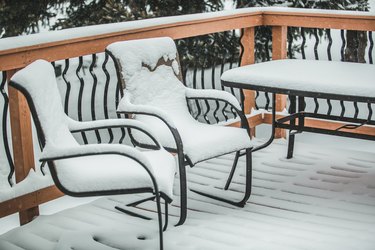
4. Prep Water Features
Water expands as it freezes and can cause a lot of damage, so it's smart to drain your backyard water features before the cold hits. Your pool is an obvious starting point, but don't overlook any smaller fountains, pools or birdbaths. Draining and covering them now not only prevents damage, it minimizes the amount of cleanup you'll need to do in spring. If you're a keen birder and want to maintain a winter destination for your feathered friends, add a heater to the bird bath or upgrade to one with heating built in.

5. Check Your Outdoor Lighting
Another important safety measure is to check your outdoor lighting before the cold weather hits. You can't avoid icy and dangerous spots if you can't see them, right? Allocate a day to make the rounds and check each light, making sure the bulb works and the fixture is solidly mounted. This is especially important with the ones that require a ladder, because you really don't want to be using a ladder on icy ground. For any lights that require a special bulb, make sure you have a spare on hand just in case it should blow during the winter.

6. Stock Up on Traction Aids
Slips and falls are one of the most dangerous — and preventable — risks you'll face this winter. One of the smartest things you can do to get ready for the cold, icy weather is simply to lay in a healthy supply of sand and snow/ice melter at the beginning of the season, when stores are well stocked. Salt can damage your grass or garden, but sand provides excellent traction and you can also find lots of snow-melting products that aren't salt. If you have pets, make sure to look for a salt alternative that's also pet friendly (some aren't).

7. Give Shrubs and Small Trees Some Protection
Even the hardiest of shrubs may need some help to survive the winter and still be intact, healthy and beautiful. The weight of ice and snow, or the combined impact of high winds and low temperatures, might otherwise cause damage that could take years to repair. For shrubs, immature trees or other modestly-sized plants, wrapping them in burlap (or even an old sheet) will do the trick. For established hedges or larger areas, erecting a temporary snow fence might be all the protection they'll require.
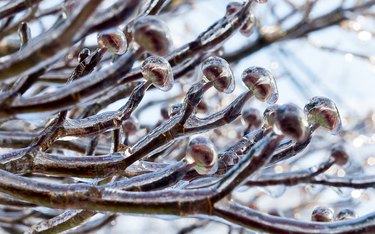
8. Mow and Rake
Dealing with autumn leaves is one of the standard late-season tasks, though how you go about it is a matter of personal preference. Some rake them while others use leaf blowers; some bag and dispose of them while others use them as mulch. Either way, clearing them from your lawn will help avoid patchy grass in spring. While you're at it, give your lawn a final — not too close — mowing for the season. Mowing too closely exposes your grass' roots to the winter cold, while leaving it too long will leave it messy in spring. Three or four inches is about right.
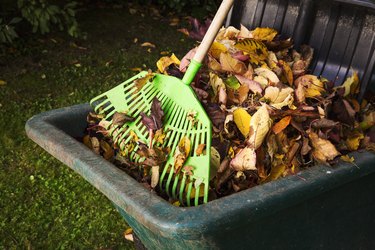
9. Mulch Perennial Beds and Shrubs
Canny gardeners often establish beds filled with perennials to act as the garden's backbone, and then fill in the spaces around those perennials each year with annuals. Those perennials will usually benefit from a little winter insulation in the form of mulch, which helps protect their roots, corms, tubers or bulbs from the hardest freezes. Straw and your autumn leaves (ideally shredded, to keep them from caking) are excellent around flowers and vegetable beds, and bark mulch or wood chips can be used around ornamentals or small shrubs.

10. Apply Dormant Oil
Autumn is when many small creatures seek out safe places to ride out the winter, and unfortunately that includes less-desirable parasites and insect pests as well as the cute woodland creatures you imagine. One way to keep them to a minimum is to apply "dormant oil," which isn't a specific type of oil but rather an oil-based treatment that's applied when the tree or shrub is dormant. The oil will be broken down and gone by spring, but in the interim it disrupts the life cycle of many creepy-crawlies that would otherwise damage your trees and garden next spring and summer.
